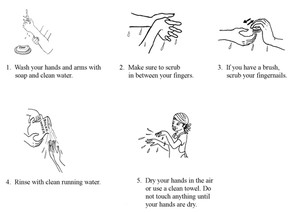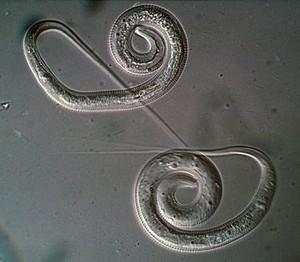Diseases associated with water
The majority of water-related health problems are caused by infectious agents that can invade the body and cause disease. They include pathogenic (disease-causing) bacteria, viruses, protozoa and parasites. Infectious agents can cause disease when they are ingested (eaten or swallowed) or otherwise come into contact with the human body. The different ways in which water is involved in this contact can be used to classify the diseases into four main groups: waterborne, water-washed, water-based and water-related diseases.
Waterborne diseases
Waterborne diseases are caused by people ingesting water contaminated by human or animal faeces containing pathogens. Such diseases can also be caused by food that has been prepared using water contaminated with pathogens. The diseases are caused only when the infectious agent enters the body. Waterborne diseases include most of the enteric (related to the intestine) and diarrhoeal diseases caused by bacteria and viruses. Bacteria are unicellular organisms (made of one cell) and are very small, ranging from 0.5 to 5.0 micrometres (µm) in size. When seen under a microscope, they have different shapes, such as spheres, rods, or spirals. Viruses are microscopic infectious particles, much smaller than bacteria, that can only reproduce when inside the living cells of organisms. Waterborne diseases also include some caused by protozoa (single-celled micro-organisms that are much larger than bacteria, usually between 10 and 50 µm) and helminths. Helminths is a general term for worms, usually applied to those that are parasites on humans and other animals. Table 2.1 shows examples of waterborne diseases and their causes.
Table 2.1 Examples of waterborne diseases.
| Category of infectious agent | Disease | Infectious agent |
| Bacterial | Cholera | Vibrio cholerae |
| Bacterial dysentery | Campylobacter jejuni | |
| (Acute) gastroenteritis | Various | |
| Shigellosis | Shigella species | |
| Typhoid fever | Salmonella typhi | |
| Viral | Viral gastroenteritis | Rotavirus and others |
| Viral hepatitis | Hepatitis A and E viruses | |
| Poliomyelitis | Polio virus | |
| Protozoal | Amoebic dysentery | Entamoeba histolytica |
| Cryptosporidiosis | Cryptosporidium | |
| Giardiasis | Giardia lamblia | |
| Helminths | Ascariasis (roundworm) | Ascaris lumbricoides |
| Dracunculiasis (Guinea worm) | Dracunculus medinensis | |
| Trichuriasis (whipworm) | Trichuris trichiura |
Although drinking contaminated water is a very significant route of transmission for many of the diseases listed above, they may also be transmitted by other means such as by eating contaminated food. Food can become contaminated by poor hygiene during preparation. Flies are also important transmitters of contamination from faeces to food. There are other possible routes of transmission, including through droplets and aerosols, if these are ingested. We use our fingers for eating and frequently put our hands to our mouths; touching contaminated surfaces can also be a route for disease transmission.
How could poor personal hygiene by people preparing food cause disease?
If cooks do not thoroughly wash their hands before touching food, they could easily transfer contamination by infectious agents. When the contaminated food is eaten, this could transmit disease to the consumers.
In all these cases, the origin of the contamination is faeces of people who are already infected by the disease. Some diseases may be transmitted via the faeces of infected animals. In places without adequate sanitation and where people defecate in the open, waterborne disease is far more likely to occur. By sanitation, we mean the prevention of human contact with wastes. If faeces are effectively separated from people then the transmission routes of waterborne diseases are cut off.
Water-washed diseases
Water-washed diseases are those that occur as a result of inadequate quantities of water being available for good personal hygiene. Good personal hygiene habits include:
- washing hands with soap, or using an alternative such as ash, after using the latrine
- washing hands before preparing and/or eating food
- washing the body frequently
- cleaning the teeth at least once a day
- washing the hair with soap or shampoo at least once a week.
Figure 2.1 shows the steps in a thorough technique for handwashing.

Figure 2.1 Handwashing technique.
Water-washed diseases are sometimes called ‘water-scarce’ diseases because they are a problem if water supply is limited. They include fungal skin diseases such as ringworm, ophthalmic diseases (diseases of the eye) such as trachoma and conjunctivitis, and infections caused or carried by lice, mites, fleas or ticks. Two examples of these diseases are scabies (caused by mites) and louse-borne epidemic typhus (caused by Rickettsia prowazekii bacteria and transmitted largely by body lice).
Adequate quantities of clean water can prevent such diseases affecting a population. Why do you think this is so?
Because if plenty of water is available, people are able to wash frequently and the disease-causing organisms will be washed away.
Water-based diseases
Water-based diseases are caused by parasites that spend part of their life cycle in water. Water-based diseases such as bilharzia (also known as schistosomiasis – this will be described in Section 2.3.3), and dracunculiasis are caused by helminths. Dracunculiasis, or Guinea worm disease, is transmitted by drinking water that is contaminated with copepods that contain the larvae of the Guinea worm (Figure 2.2). Copepods are very small crustaceans, sometimes known as water fleas, that are found in the sea and in fresh water. The Guinea worm larvae get into the water by emerging through the skin of an infected person while they are washing or bathing. To prevent dracunculiasis infection, effective water treatment is needed. A global campaign to eradicate Guinea worm has made great progress in reducing the incidence of the disease and it is now found in only a few countries in the world. Ethiopia is one of them, but the disease is now rare; only three cases were reported during 2014 (WHO, 2015). (Note that transmission of dracunculiasis requires drinking of contaminated water and it can, therefore, be classified as both a waterborne and a water-based disease.)

Figure 2.2 Guinea worm: the parasite that causes the disease dracunculiasis. The worm is 1–2 mm wide and can grow up to 100 cm long.
Water-related diseases
Water-related diseases are transmitted by insects that breed or feed in or near water bodies. The best-known example is malaria, which is spread by the Anopheles mosquito (this disease will be described in Section 2.3.2). Water-related diseases are not associated with lack of access to clean drinking water or to hygiene and sanitation services. The significant factor is the presence of standing water, which provides a habitat for the insects to breed. Other water-related diseases include onchocerciasis (spread by blackfly), dengue fever and yellow fever (both spread by mosquitoes).